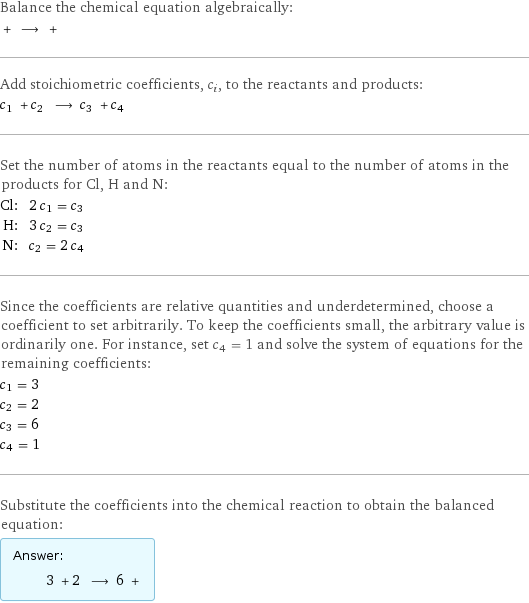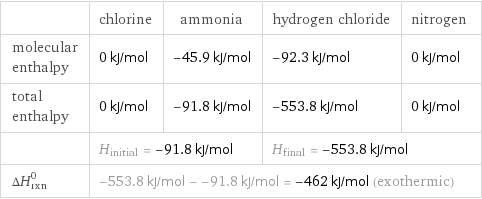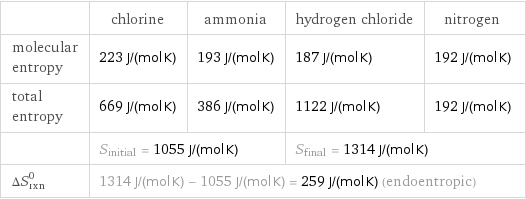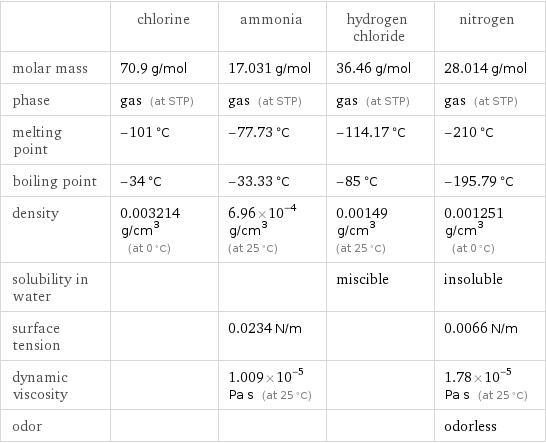Input interpretation

chlorine + ammonia ⟶ hydrogen chloride + nitrogen
Balanced equation

Balance the chemical equation algebraically: + ⟶ + Add stoichiometric coefficients, c_i, to the reactants and products: c_1 + c_2 ⟶ c_3 + c_4 Set the number of atoms in the reactants equal to the number of atoms in the products for Cl, H and N: Cl: | 2 c_1 = c_3 H: | 3 c_2 = c_3 N: | c_2 = 2 c_4 Since the coefficients are relative quantities and underdetermined, choose a coefficient to set arbitrarily. To keep the coefficients small, the arbitrary value is ordinarily one. For instance, set c_4 = 1 and solve the system of equations for the remaining coefficients: c_1 = 3 c_2 = 2 c_3 = 6 c_4 = 1 Substitute the coefficients into the chemical reaction to obtain the balanced equation: Answer: | | 3 + 2 ⟶ 6 +
Structures

+ ⟶ +
Names

chlorine + ammonia ⟶ hydrogen chloride + nitrogen
Reaction thermodynamics
Enthalpy

| chlorine | ammonia | hydrogen chloride | nitrogen molecular enthalpy | 0 kJ/mol | -45.9 kJ/mol | -92.3 kJ/mol | 0 kJ/mol total enthalpy | 0 kJ/mol | -91.8 kJ/mol | -553.8 kJ/mol | 0 kJ/mol | H_initial = -91.8 kJ/mol | | H_final = -553.8 kJ/mol | ΔH_rxn^0 | -553.8 kJ/mol - -91.8 kJ/mol = -462 kJ/mol (exothermic) | | |
Gibbs free energy

| chlorine | ammonia | hydrogen chloride | nitrogen molecular free energy | 0 kJ/mol | -16.4 kJ/mol | -95.3 kJ/mol | 0 kJ/mol total free energy | 0 kJ/mol | -32.8 kJ/mol | -571.8 kJ/mol | 0 kJ/mol | G_initial = -32.8 kJ/mol | | G_final = -571.8 kJ/mol | ΔG_rxn^0 | -571.8 kJ/mol - -32.8 kJ/mol = -539 kJ/mol (exergonic) | | |
Entropy

| chlorine | ammonia | hydrogen chloride | nitrogen molecular entropy | 223 J/(mol K) | 193 J/(mol K) | 187 J/(mol K) | 192 J/(mol K) total entropy | 669 J/(mol K) | 386 J/(mol K) | 1122 J/(mol K) | 192 J/(mol K) | S_initial = 1055 J/(mol K) | | S_final = 1314 J/(mol K) | ΔS_rxn^0 | 1314 J/(mol K) - 1055 J/(mol K) = 259 J/(mol K) (endoentropic) | | |
Chemical names and formulas

| chlorine | ammonia | hydrogen chloride | nitrogen Hill formula | Cl_2 | H_3N | ClH | N_2 name | chlorine | ammonia | hydrogen chloride | nitrogen IUPAC name | molecular chlorine | ammonia | hydrogen chloride | molecular nitrogen
Substance properties

| chlorine | ammonia | hydrogen chloride | nitrogen molar mass | 70.9 g/mol | 17.031 g/mol | 36.46 g/mol | 28.014 g/mol phase | gas (at STP) | gas (at STP) | gas (at STP) | gas (at STP) melting point | -101 °C | -77.73 °C | -114.17 °C | -210 °C boiling point | -34 °C | -33.33 °C | -85 °C | -195.79 °C density | 0.003214 g/cm^3 (at 0 °C) | 6.96×10^-4 g/cm^3 (at 25 °C) | 0.00149 g/cm^3 (at 25 °C) | 0.001251 g/cm^3 (at 0 °C) solubility in water | | | miscible | insoluble surface tension | | 0.0234 N/m | | 0.0066 N/m dynamic viscosity | | 1.009×10^-5 Pa s (at 25 °C) | | 1.78×10^-5 Pa s (at 25 °C) odor | | | | odorless
Units
